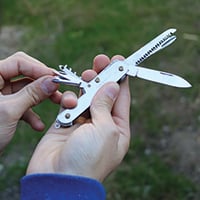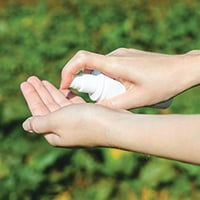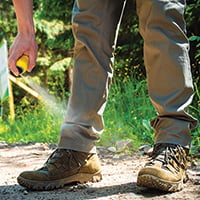Summer Issue 2022
From the President

Summer greetings from the Forest Preserve District! I sincerely hope you’re able to get out and enjoy all your forest preserves have to offer. We’re pleased to present a robust lineup of activities and events this season, so whether you’re interested in kids programs, golf, camping, or simply spending time in nature, we have something for everyone.
This summer will also be a busy time for forest preserve improvements. As you travel throughout the county, you’ll see many projects underway. In April, the board approved the final master plan and contract for the new Willowbrook Wildlife Center. This multiyear project will transform Willowbrook into a state-of-the-science center that will serve as a national leader in animal care, rehabilitation, and education for decades. Other summer efforts include a new parking lot at Waterfall Glen, exterior structural improvements at Mayslake Hall, new flushable family restrooms at Wood Dale Grove and Waterfall Glen, and bridge replacements at Hidden Lake. Throughout the District, you’ll also see crews performing regular maintenance and working on important infrastructure and natural restoration projects.
As you enjoy our preserves and programs, please stay safe. Our rangers and police officers are available to assist 365 days a year. As you visit some of the preserves this summer, you may see new security cameras at the entrances. These have been installed to deter crime and protect our visitors. Public safety is a top priority, so if you see something, say something.
I wish you a great summer enjoying nature (and encourage you to check out “Top 10 Trail Trip Must-Haves” on Page 19 before you head out). If you have any questions or concerns, I can be reached at dhebreard@dupageforest.org. I’ll see you on the trails!

Daniel Hebreard
President, Forest Preserve District of DuPage County
News & Notes
Fish to Gain New Passageway at McDowell Grove

The Fawell Dam located in the West Branch DuPage River at McDowell Grove is an important flood-control structure. Owned and managed by DuPage County Division of Stormwater, the dam’s three gates control the flow through three large concrete box culverts, protecting Naperville from flooding by lowering downstream flood-stage elevations.
But the dam also creates an upstream barrier to fish, many of which are returning to this stretch of the river as water quality and habitat steadily improve. Surveys between 2007 and 2020 have shown that 12 species of native fish such as flathead catfish, rock bass, blackstripe topminnows, and emerald shiners are only found downstream of the structure.
Finding a way for fish to bypass the dam was technically challenging, but DuPage County, the Forest Preserve District, and the DuPage River Salt Creek Workgroup are working together to install a patented fishway by BK-Riverfish in Amherst, Massachusetts, to do the job. The metal chute is divided by baffles into small pools, which will allow fish to swim from pool to pool from the bottom upstream to the top. (They’ll be able to swim downstream as well.) The agencies involved expect the fishway to be completed by 2023. Image © BK-Riverfish LLC, Amherst, MA
Collections Corner

Whether at construction sites, in closets, or in relatives’ attics, people unexpectedly discover historic items every day. In that moment, the finder may be unsure of what to do next. When the Forest Preserve District discovers a new find, it can face the same dilemma.
Thankfully, the District is guided by policies that help make the task easier. A “scope of collections” policy creates helpful boundaries, ensuring proper care and use of each item. With it, the District considers issues like provenance (where did it come from), ownership (who actually has a claim to it), purpose (how can it connect residents to the land through its past), and legal expectations (which laws affect it). Just as local historical societies and museums do, the Forest Preserve District ensures that each artifact added to its collection holds a specific place in the history of the people and the public lands of DuPage. Image sirtravelalot/Shutterstock.com
Live and on Demand

Can’t make it to a board meeting? Find schedules and agendas and watch it live or on demand under “Our Board.” You can also link directly to live streaming video from the Forest Preserve District’s Facebook page at facebook.com/dupageforest.
Commission meetings and planning sessions are open to the public and held at Forest Preserve District headquarters at 3S580 Naperville Road in Wheaton. Normally, commission meetings are at 8 a.m. on the first and third Tuesdays of the month; planning sessions, 8 a.m. on the second and fourth Tuesdays. At both, the board hears public comments and staff reports, discusses business, and votes on agenda items.
Visitor Services Saturday Phone Hours

Now through Aug. 27 (except July 2), Visitor Services will be available on Saturdays 9 a.m. to 2 p.m. to answer your calls, emails, and online chats. The office won’t be open for in-person visits, but you’ll still get answers to all those questions you missed during the week. Get in touch at 630-933-7248 or permits@dupageforest.org, or use our chat box at dupageforest.org.
To reach the office during these hours, call 630-933-7248, email permits@dupageforest.org, or chat online at dupageforest.org. Image lzf/Shutterstock.com
The Preserve Welcomes First Full Season With New Clubhouse

Golfers and any groups looking for a place to meet are enjoying great views at The Preserve at Oak Meadows new clubhouse.
The one-story, 18,000-square-foot building has environmentally-friendly features, such as a green roof, native landscaping with pollinator-friendly plants, sustainably sourced wood, and energy-efficient building systems. It also features a restaurant with indoor and outdoor seating areas, a multipurpose event room, a pro shop, locker rooms, and office space.
The chef’s menu at the Greenway Tap restaurant includes sandwiches, salads, healthy inspirations, and featured plates. For details, including current hours and directions, visit DuPageGolf.com.
Successful Rehab Story Has Happier Ending

In January, a concerned birder contacted the Chicago Bird Collision Monitors group to collect a bald eagle she spotted in a puddle at the side of the road. The volunteers brought the eagle to Willowbrook Wildlife Center, which concluded the animal suffered from rodenticide poisoning, most likely from eating a poisoned mouse or rat.
After almost 40 days of treatment, the bird was healthy enough to return to the wild, and center staff released it (pictured above) near the spot where it had originally been found. Shortly thereafter, observers spotted the eagle reuniting with its mate.
In May, the same birder spotted the pair’s nest — now occupied by two eaglets as well!
Birding News

The Bird Conservation Network, a coalition of 21 conservation organizations in the six-county Chicago region, recently analyzed 22 years of bird survey data collected within local natural areas, including 45 DuPage forest preserves. The survey results, which are posted at bcnbirds.org/trends21, indicate that preservation and restoration efforts within forests, prairies, wetlands, and shrublands are benefiting many species.
Of the 104 species analyzed, 56% are stable or increasing within our region, compared to only 37% for the rest of Illinois. The study also concluded that grasslands within the six-county study are globally important for Henslow’s sparrows (shown above) and that management efforts have benefited this species tremendously. However, many breeding birds such as bobolinks and ovenbirds are declining, demonstrating a clear need to continue focusing on conservation practices that benefit birds.
Also of note, our region may be the single-most important migration corridor in North America, providing much-needed food and shelter for migratory species.
A special thank you is extended to the 66 District volunteers who contributed to this data set over the past two decades!
Many Thanks

The Forest Preserve District thanks the donors who contributed to its efforts Jan. 1 - March 31. To learn how your financial support can benefit the District, visit dupageforest.org/friends. To give to the 501(c)(3) nonprofit Friends of the Forest Preserve District, visit dupageforestgiving.org/donate.
Gifts of Note
Richard Pena and Edith Podrazik
$1,500 – Willowbrook Wildlife Center
Anthony and Joyce Carey
$1,000 – Willowbrook Wildlife Center
Dennis Dean
$500 – Willowbrook Wildlife Center
Gifts of Note to the Friends of the Forest Preserve District
Jeffrey Jens
$75,000 – Green Energy Endowment Fund
Ann Boisclair
$25,000 – Green Energy Endowment Fund
Estate of Beth Fikar
$25,000 – Willowbrook Wildlife Center capital projects
Dare Family
$6,000 – Willowbrook Wildlife Center
Domtar Paper Company
$3,500 – Natural Resources, Willowbrook Wildlife Center Adopt an Animal
Edward Jones Financial Advisors
$2,500 – Greatest needs
Gerald and Amy Tavolino
$2,500 – Willowbrook Wildlife Center in memory of Gayle Ann Reed
Susan Johansen
$1,500 – Willowbrook Wildlife Center Adopt an Animal
Patrick and Mary Mauro
$1,300 – Mayslake Peabody Estate restoration capital projects
Anonymous
$1,000 – Willowbrook Wildlife Center
Jay Boryscka
$1,000 – Willowbrook Wildlife Center in honor of Suzanne Boryscka
COUR Pharmaceuticals
$1,000 – Greatest needs in memory of Frank Podijil
Bruce Lauer
$1,000 – St. James Farm in memory of Holden Wight
Frank and Patricia Moscardini Jr.
$1,000 - St. James Farm in memory of Holden Wight
Matthew and Jaime Szafranski
$1,000 – St. James Farm in memory of Holden Wight
Nancy Hermann
$550 – Greatest needs
Jeremy Caulk
$500 – Willowbrook Wildlife Center in memory of Gayle Ann Reed
Jennifer Chidlow
$500 – Natural Resources Restoration Capital Projects
Anthony Komro
$500 – St. James Farm in memory of Holden Wight
Manhard Consulting
$500 – Greatest needs
Mallory Neuberg
$500 – Willowbrook Wildlife Center in memory of Peeps and Margo
The Social Lives of Crows
Mobbing, holding a grudge, funerals, murders. They may sound like popular themes for a crime story, but they’re also a few of the behaviors of the American crow.
American crows are common sights in DuPage forest preserves and backyards. Most people know these large black birds for their diverse diet (nuts, fruits, seeds, insects, bird eggs, small mammals, garbage, carrion) and their distinctive “caw, caw” vocalizations, but many may not know that researchers study crows for their complex social behaviors and intelligence.
Crows are social animals that often live in extended family groups. Young will stay with their parents for up to two years as “helpers” to aid in building nests and rearing and protecting new chicks. As older birds, crows gather in large groups, hanging out at night in roosts containing one or two dozen to thousands of individuals and dispersing during the day to forage for food.
This communal social system is especially seen in crows’ mobbing behavior, a defensive strategy the birds use when a predator is nearby. If a crow discovers a hawk, owl, or other danger in its territory, it will start to harshly caw. This alarm attracts other crows, who join in the calling. (If you ever hear a group of crows cawing like this, be on the lookout for a bird of prey!) Some may even dive bomb the intruder. This effective behavior usually causes the predator to move on.
Crows are also known to carry — and pass on — grudges. In one study, researchers from the University of Washington wore caveman masks and then captured, marked, and released several crows. They then took turns wearing the mask around campus, noting the birds’ responses. Crows that were captured cawed at the person wearing the mask but ignored other people and even other masks. But the crows that were never captured seemed to quickly learn that the caveman mask represented danger as they, too, began to scold and target the person wearing it. The researchers concluded that the captured crows not only held grudges against the person in the caveman mask but also taught other crows that the mask was a danger to avoid.
One of the more interesting behaviors of crows, which is not common in the animal world, is a funeral or wake for a deceased member of the group. Researchers, again from the University of Washington, placed a taxidermied crow outdoors. When a crow discovered the deceased, it would call out, alerting others. As other crows gathered, the group continued to make noise. The researchers theorized that the crows were sending a call out to look for nearby predators or other threats that may have caused the death. The study also revealed that if a predator or human was in the area when the crows gathered, they would scold that individual — even weeks later.
Another interesting fact, one based on folklore, is that a group is called a “murder,” although no one knows exactly why. In the 15th century, the English liked to assign collective nouns to groups of animals, often using poetic or colorful names based on perceived characteristics or superstitions. Crows might have received the term “murder” because they were often linked with death, perhaps because of their black plumage or the fact that they ate carrion and were often seen on battlefields. Another possible origin story suggested that a group of crows would act as judge, jury, and executioner against an individual within the group. Regardless of the reason, a “murder of crows” remains a well-known description, although by no means a scientific one.
As for overall intelligence, crows have demonstrated impressive abilities in the ways they work individually and in groups to gather food. Researchers have observed crows using cups to pour water over dry foods to make the meals easier to consume. They’ve seen crows pry slender pieces of wood from fence posts to use as tools to reach into holes to grab insects. Crows will work together to distract river otters before stealing food from the unsuspecting aquatic mammals. And crows have been recorded digging holes to get clams, stealing food from humans and pets, and dropping nuts on hard surfaces to crack open the shells to reach the nuts inside.
Their social and intelligent behaviors make crows well-adapted to living throughout DuPage County. Their close-knit family groups offer an added layer of protection from predators and provide effective means of communicating danger. Their intelligence allows them to observe danger and to pass on what they learn to future generations.
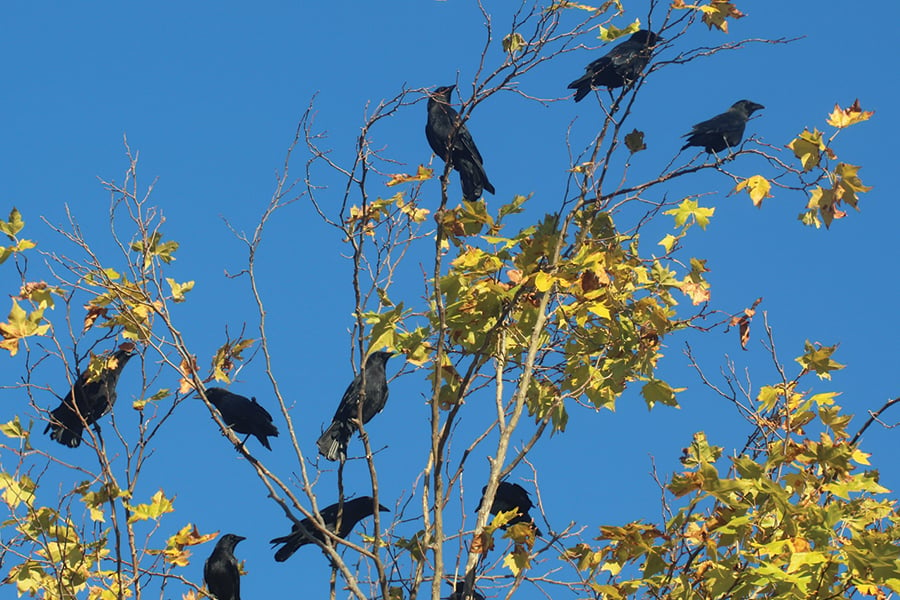
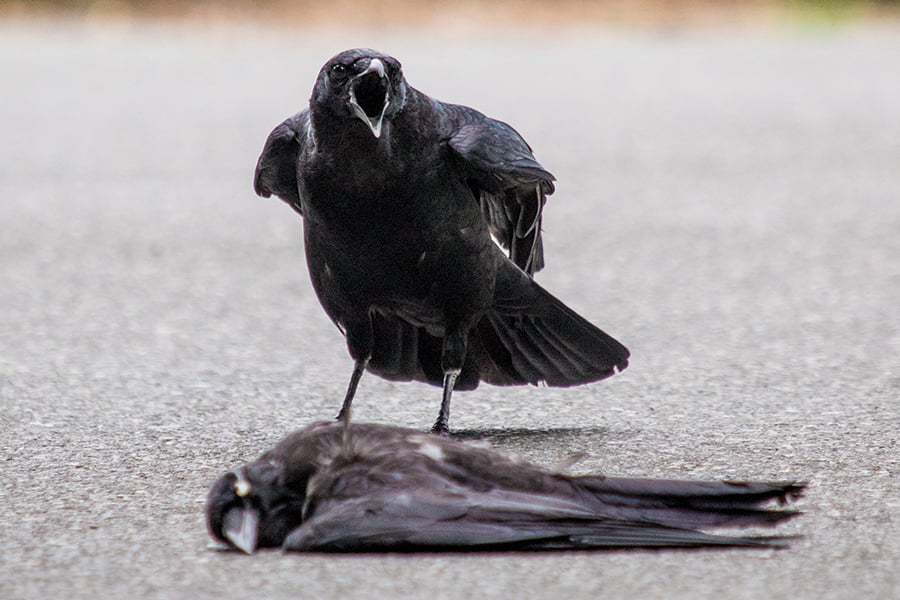

Top 10 Trail Trip Must-Haves
It’s not news that since 2020, more people are finding time to spend outdoors. In DuPage, a lot of that time includes hiking or biking along the county’s 166 miles of trails. But whether you’re headed to a local forest preserve or a weekend in the wilds of Wisconsin, there are 10 items (featured here in no particular order) that can help you avoid discomfort or the need to turn back before your adventure is over.
1. Water
Water is vital no matter what time of year you go on a hike or bike ride. Most experts recommended you bring at least 32 ounces in a rugged bottle. A wide-mouth bottle is usually better because it’s easier to clean and fill. For longer or hotter trips, you may want to bring more, although most forest preserves have pumps or fountains. You can find out where each is located on any DuPage forest preserve map.
2. Charged Phone
The plan might be for a quick trip to the preserves, but as the Scouts like to say, “Be prepared!” A fully charged smartphone gives you peace of mind in an emergency and the latest weather report. It also guarantees you’ll have your camera at the ready to take all of those great shots of DuPage plants and wildlife. (Tag us at #dupageforest if you post them on social media!) Plus, you’ll be able to pull up information on the preserves — including trail maps — at dupageforest.org.
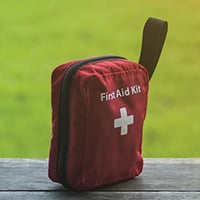
3. First Aid Kit
No matter the extent of your adventure, you’ll want to bring at least a basic first aid kit. If you’re hiking in the backwoods, you’ll want one that can treat minor injuries and provide initial care for more serious emergencies. In DuPage forest preserves, just the basics will save your trip if you get a blister, minor cut, or sting. (In more serious emergencies in the preserves, dial 911.)
4. Extra Layers
No matter how good we are with checking the weather, it can change when we least expect it. Regardless of where you’re headed, have the clothing you need to deal with the extremes of heat, cold, and storms. If you are out in colder temperatures, dress in layers so you can remain comfortable as you remove or add different garments. Outdoor clothing can be a little expensive, but many styles are compact, which makes them easier to carry. Bring a spare pair of socks, too. When hiking, your feet are your most important asset, and having extra socks can make a world of difference if you end up with wet feet.
5. Rain Gear
This is separate from “extra layers” because it’s that important. Even on warmer days, you can get chilled by an unexpected storm. If possible, invest in a good rain suit that includes a jacket and pants. Rain ponchos and garbage bags with holes for your head and arms are not recommended because they restrict movement and don’t trap the warmth near your body.
6. Snacks
Even if it’s a short hike, it’s a good idea to bring a small supply of high-energy, high-nutrition foods (such as one of the trail mixes below). These foods will give you that extra boost if your hike lasts longer than expected. Hiking and biking use a lot of energy, and even a short trek can make bellies grumble. Having these snacks on hand will help you focus less on hunger and enjoy more of the journey ahead.
7. Map and Compass
Smart phones do a lot for us. You can use them to pull up a trail map in a matter of seconds. But this technology is only good if it works. If you drain your battery or lose your network signal, you could be out of luck. That’s why you should carry a map and compass and know how to read and use each. You can print trail maps in advance from dupageforest.org for most forest preserves. If you need some pointers, the Forest Preserve District has a compass course activity at Blackwell that’ll help you learn how to use this navigational tool by following a series of directions. To make a free reservation, call Visitor Services at 630-933-7248.
8. Multitool
Over the years, the good, old pocket knife has evolved into the mighty multitool. There are dozens of options to choose from, but don’t feel you have to run out and purchase the biggest one there is. Think about where you’re going and what you might need. They all come with one or two blades, but one with tweezers can help with splinters, and one with a flathead or Phillips screwdriver can help with bike repairs. Make sure, though, to keep it oiled and sharpened. Well-cared-for equipment can last through many adventures.
9. Sun Protection
The sun makes time on the trails pleasant, but if you’re unprepared, it can lead to sunburn, heat exhaustion, or heat stoke. Make sure to stay hydrated, use sunscreen, and wear a wide-brimmed hat. Look, too, for clothes with an ultraviolet protection factor, which shows how much ultraviolet radiation a fabric allows to reach your skin. For example, UPF 50 allows just 1/50th of rays (just 2%) to penetrate. And don’t forget a well-fitting pair of sunglasses; your eyes need protection from the sun, too.
10. Bug Spray
If it’s warm out, it’s good to be mindful of biting ticks, mosquitoes, and chiggers. The best line of defense is to wear closed-toe shoes, socks, long pants, and a long-sleeved shirt. (If you tuck your pants into your socks, you’ll create an extra barrier that’ll keep out ground-dwelling ticks and chiggers.) But summer sometimes calls for shorts, so regardless of your attire, you may also want to consider properly applied repellent containing DEET or Picaridin.
Trail Mix Recipies
Trail mix is a high-protein, high-fat snack that’s perfect for any outdoor adventure. Many people call trail mix “gorp,” which some say is an acronym for “good old raisins and peanuts.” Others insist it stands for “granola, oats, raisins, and peanuts.” Adding to the debate is the 1913 Oxford English Dictionary, which defines the word as a verb meaning “to eat greedily.”
No matter what you call this sweet and salty snack, here are few recipes you can try (adjusting to address any food allergies) using equal parts of each ingredient to create your own favorites!
Traditional Gorp
Cheerios
Raisins
M&M’s or chocolate chips
Peanuts
Tropical Fruit Mix
Banana chips
Dried mango
Dried pineapple
Cashews
Macadamia nuts
Seed-Lovers Mix
Pumpkin seeds
Sunflower seeds
Dried cranberries
Walnuts
Chocolate chips
Savory Mix
Roasted cashews
Sunflower seeds
Sesame sticks
Pistachios
Wasabi peas
Images 1. Dmytro Melnyk/Shutterstock.com, 2. Izf/Shutterstock.com, 3. Kittisak Srithorn/Shutterstock.com, 5. Jaromir Chalabala/Shutterstock.com, 8. Gorkem Kisaoglu/Shutterstock.com, 9. Irina Shatilova/Shutterstock.com, 10. Crisp0022/Shutterstock.com, trail mix Hong Vo/Shutterstock.com



